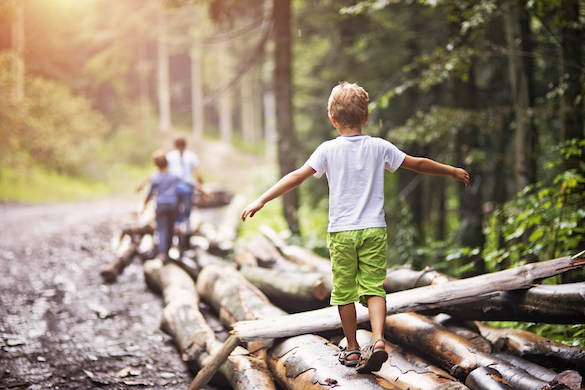
In recent years, the amount of time that children have to play outside has shrunk, particularly during school hours. More than 30,000 schools in the United States have eliminated time for recess and one estimate indicates that children spent nearly 50% less time outdoors in 2003 compared to 1997.
Yet, more and more research points to the value of nature as an environment that supports children’s learning. Outdoor environments provide a context for children to gain skills across developmental domains. Importantly, this learning occurs in any outdoor context, whether it’s an urban sidewalk, the neighborhood park, or a nature preserve. In these environments, children build cognitive, social emotional, and physical skills in natural environments. What does learning from outdoor play and nature look like?
Imagine a group of children playing in a park. Some children are playing tag in an open space. A couple of children are swinging on a swing set, and others are walking along a log. This play scene represents a wealth of learning for these young children.
First, there are many opportunities here for physical development. Children are practicing a variety of gross motor skills when they are running, swinging, and balancing on the log. They are challenged to walk on uneven ground and explore new spaces. Researchers at the University of Washington have found that as recently as 2015, children in preschool were not receiving as much time for physical activity as is recommended to protect against obesity and other health-related issues. Giving young children time for physical activity is critical for their health and their learning.
In addition to physical activity, children in this scene are building cognitive skills. They may be engaged in pretend play, if they imagine that the log is a bridge over shark-infested waters, or if swinging higher will let them touch the sky. Pretend play allows children to think symbolically about objects, like pretending that a log is a bridge. Some researchers have even suggested, “children’s play in natural settings is more diverse and includes more imaginative and creative play” (Acar & Torquati, 2015). In this scene, children are also honing their communication skills. Perhaps they articulated the rules for the game of tag to a friend or describe the animals living in the pretend water under the log. Cognitive skills are in use during all outdoor play and nature exploration.
Finally, there is an enormous amount of social and emotional development that takes place in outdoor settings. Children are negotiating rules for games, resolving conflicts with one another, and even developing empathy toward the creatures they encounter. By naming the critters you see and talking about where they live and what they eat, children begin to develop empathy for the living beings around them. Beyond empathy, outdoor play encourages children’s social skills with each another. Recent research at I-LABS has even found that when children swing in sync with one another, they are developing cooperation skills that are an important feature of social and emotional development.
In sum, outdoor play and the natural environment provide an amazing platform for children’s learning. At I-LABS, we like to think of children as baby scientists, conducting little experiments to build their understanding of the world they live in. Outdoor play and nature exploration provides children with an opportunity to explore their world with all of their senses, ask questions, and think creatively. As adults, we can support children’s learning by following their lead on activities, modeling our own exploration of nature, using natural materials in creative ways, and asking questions and commenting on children’s discoveries. When children see the ant on the log, ask them where it’s headed or ask them to describe what the bark feels like. Taking advantage of summer weather can also mean a lot of learning for children!
